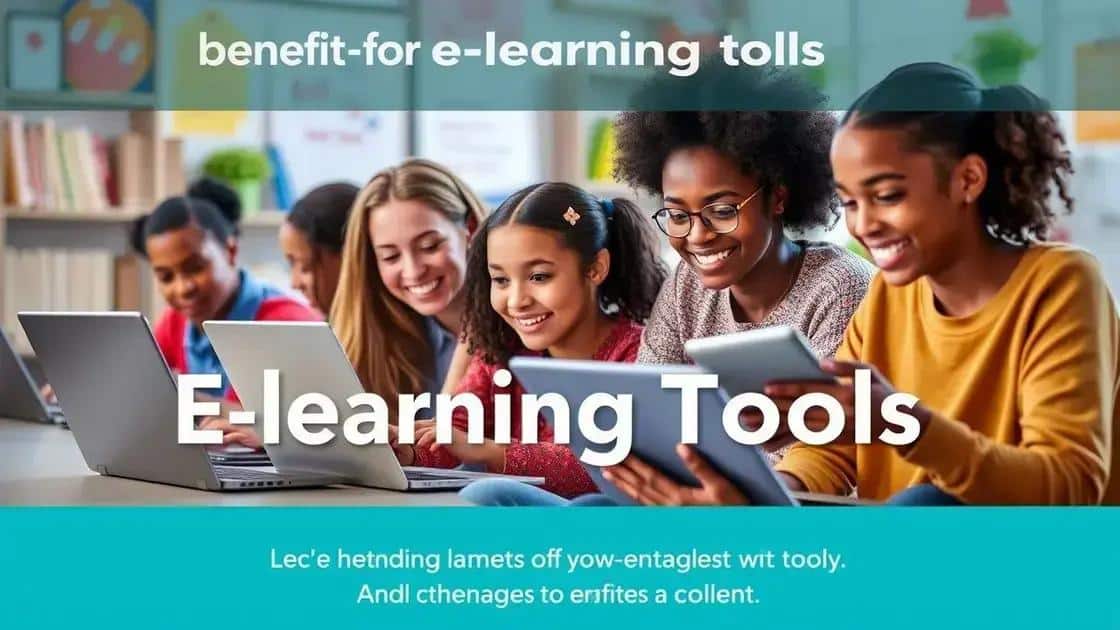E-learning tools: revolutionizing education for everyone

Anúncios
E-learning tools enhance education by providing flexibility, personalized learning through AI, and engaging environments via immersive technologies, making learning accessible for all ages.
E-learning tools have changed the landscape of education, making learning more accessible and flexible for everyone. Have you ever wondered how these tools can benefit your learning journey? Let’s dive in!
Anúncios
Understanding e-learning tools
Understanding e-learning tools is essential for anyone looking to enhance their education experience. These tools can transform traditional learning into interactive and engaging experiences.
Types of e-learning tools
There are several categories of e-learning tools available today. Each type serves different educational needs:
- Learning Management Systems (LMS): Platforms like Moodle and Blackboard help manage courses and track student progress.
- Collaboration Tools: Tools like Google Classroom allow students and teachers to work together seamlessly.
- Content Creation Tools: Applications like Articulate and Adobe Captivate enable the creation of engaging learning materials.
The integration of these tools into education makes learning more flexible. Students can access materials anytime, anywhere. This flexibility can lead to a more personalized learning experience. Moreover, e-learning tools often incorporate multimedia elements, making lessons more captivating.
Anúncios
Benefits of e-learning tools
When utilizing e-learning tools, many advantages come to light:
- Accessibility: Learners from various backgrounds can access quality education without geographical constraints.
- Cost-Effective: They often reduce costs related to traditional learning, such as commuting and materials.
- Engagement: Interactive features keep students motivated and focused.
As technology advances, e-learning tools will continue to evolve, providing innovative solutions to enhance education.
Benefits of using e-learning tools

The benefits of using e-learning tools are numerous and impactful, especially in today’s fast-paced world. These tools offer unique advantages that can transform the educational experience.
Enhanced Flexibility
One major benefit is flexibility. With e-learning tools, students can learn at their own pace. This means they can review materials as many times as needed, leading to better understanding.
- Anytime Access: Learners can access course materials whenever they want.
- Self-Paced Learning: Students can spend more time on difficult subjects.
- Location Independence: Education can occur anywhere, not just in a classroom.
Another significant advantage is cost-effectiveness. Many e-learning tools reduce or eliminate costs associated with traditional education, such as commuting and textbooks. This affordability opens doors for more individuals to pursue education, contributing to lifelong learning.
Interactive Learning Experiences
Engagement is also a key benefit of e-learning tools. Features such as quizzes, discussion boards, and multimedia content keep learners engaged. By utilizing these interactive elements, students often find the material more enjoyable and easier to digest.
- Gamified Learning: Adding game-like elements can make learning fun.
- Multimedia Content: Videos and animations can enhance understanding.
- Peer Collaboration: Discussion platforms allow teamwork and communication.
Overall, using e-learning tools supports various learning styles. Whether a student learns better visually, auditorily, or kinesthetically, there’s a tool that can cater to their needs. By embracing these tools, both educators and students can foster a richer educational environment.
Popular e-learning tools in 2023
In 2023, various popular e-learning tools are making waves in the education sector. These tools cater to learners and educators, making education more interactive and accessible.
Learning Management Systems (LMS)
Many institutions rely on Learning Management Systems to organize their courses. Platforms like Moodle and Canvas stand out due to their user-friendly interfaces and extensive features. They allow educators to manage courses, track student progress, and facilitate communication.
- Moodle: An open-source platform known for its flexibility and customization options.
- Canvas: A cloud-based LMS that supports multimedia and mobile learning.
- Blackboard: Offers a comprehensive set of tools for education management.
These systems are essential as they help streamline educational processes, making administrative tasks simpler.
Collaboration Tools
Collaboration is another vital aspect of learning, and tools like Google Classroom and Microsoft Teams have gained immense popularity. These platforms facilitate communication and collaboration among students and teachers.
- Google Classroom: Integrates seamlessly with other Google services, allowing easy sharing of files.
- Microsoft Teams: Combines chat, video conferencing, and file sharing in one platform.
- Slack: Popular for real-time communication, especially in group projects.
Using collaboration tools enhances teamwork skills, which are crucial in today’s job market.
Content Creation Tools
Creating engaging content is easier with tools like Canva and Adobe Spark. These tools allow educators to design visually appealing materials that capture students’ attention.
- Canva: A graphic design tool perfect for creating presentations, infographics, and flyers.
- Adobe Spark: Allows users to create videos and web pages easily.
- Nearpod: Enables interactive lessons with assessments integrated into the content.
Such content creation tools are vital for making learning stimulating and enjoyable.
Future of e-learning tools in education

The future of e-learning tools in education looks promising and exciting. As technology advances, these tools will continue to evolve, making learning more accessible and engaging.
Integration of Artificial Intelligence
One major trend is the integration of artificial intelligence (AI). AI can personalize learning experiences for students, adapting to their unique needs. With intelligent algorithms, e-learning platforms can analyze student performance and suggest tailored resources for improvement.
- Adaptive Learning: Systems that adjust content based on student progress.
- Chatbots: Providing instant support for learners whenever they need help.
- Data Analytics: Helping educators track student engagement and success.
This technology aims to create a more individualized learning path, fostering better educational outcomes.
Immersive Learning Environments
Another exciting development is the use of virtual reality (VR) and augmented reality (AR) in e-learning tools. These technologies offer immersive learning experiences that can enhance understanding and retention of information.
- Virtual Field Trips: Allowing students to explore places they may never visit.
- Interactive Simulations: Helping students practice real-world skills in a safe environment.
- Enhanced Engagement: Making lessons more interactive and fun.
Such immersive environments can significantly boost motivation and engagement among students.
Expansion of Mobile Learning
As mobile technology continues to improve, the expansion of mobile learning will also play a significant role in the future of e-learning tools. With the rise of smartphones and tablets, learners can access educational resources anywhere, anytime.
This flexibility allows for continuous learning opportunities. Educators are already creating mobile-friendly content that is easy to navigate. This trend is likely to grow, as more institutions prioritize accessible learning for all students.
Overall, the future of e-learning tools in education promises innovations that will enhance how we teach and learn, making education more effective and engaging.
FAQ – Frequently Asked Questions about e-learning tools
What are e-learning tools?
E-learning tools are digital platforms that facilitate online education and training, making learning more accessible and interactive.
How do e-learning tools benefit students?
E-learning tools provide flexibility, allowing students to learn at their own pace, access resources anytime, and engage with interactive content.
What role does AI play in e-learning?
AI personalizes learning experiences by adapting content to students’ needs, helping to enhance their educational outcomes.
Are e-learning tools suitable for all ages?
Yes, e-learning tools are designed for learners of all ages, from children to adults, and can cater to various learning styles.






